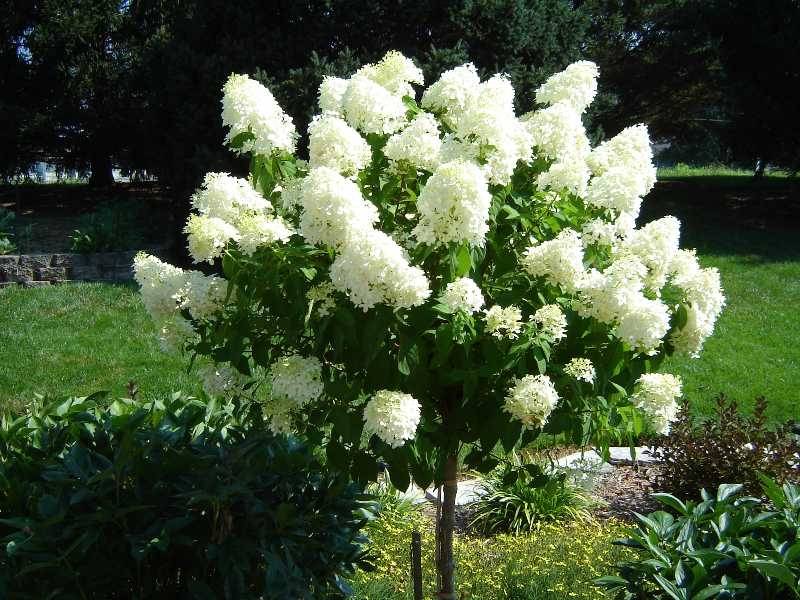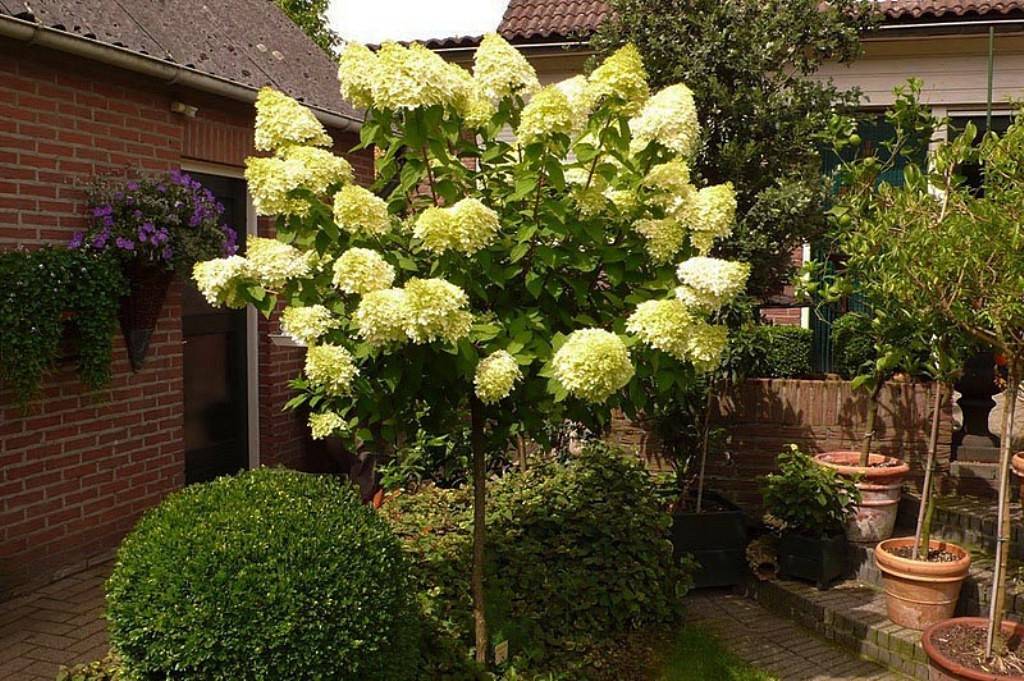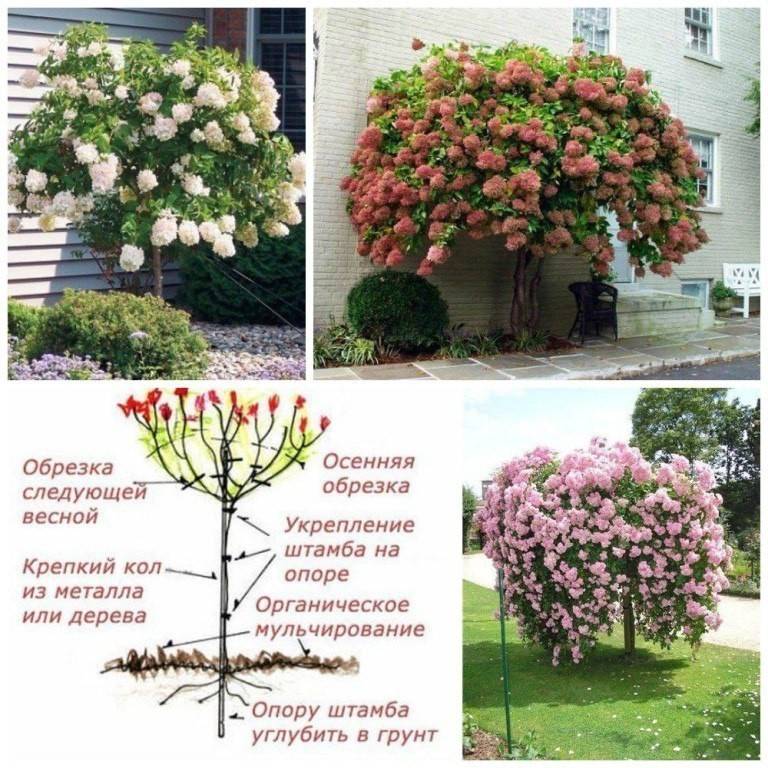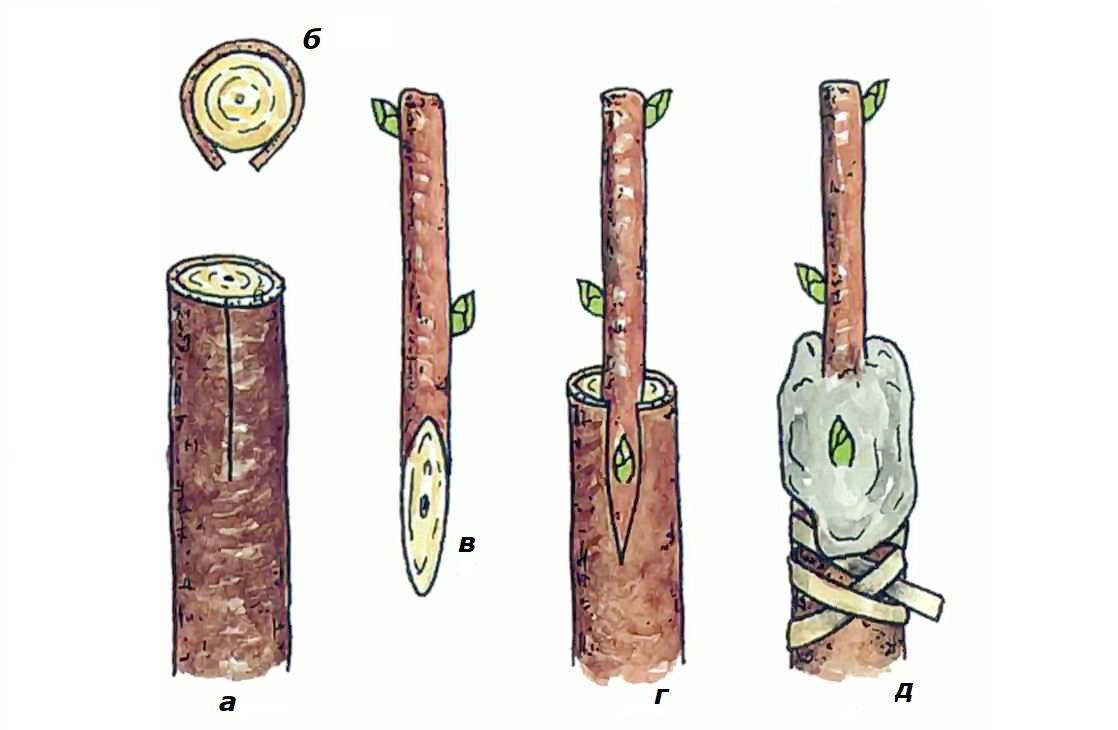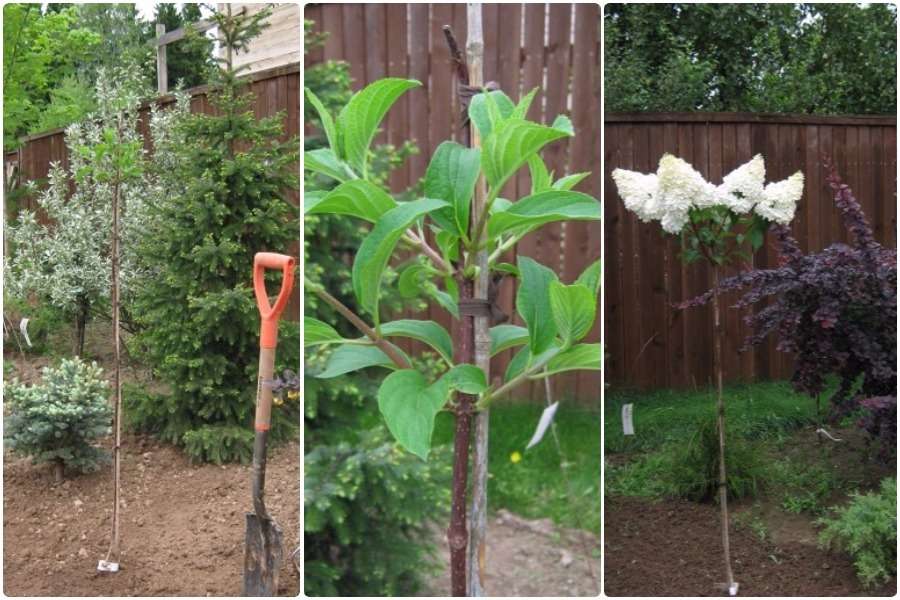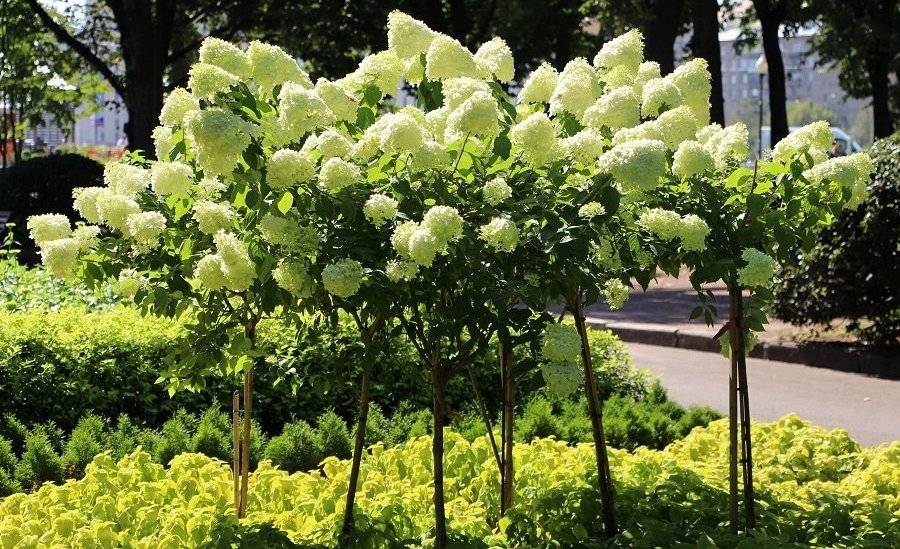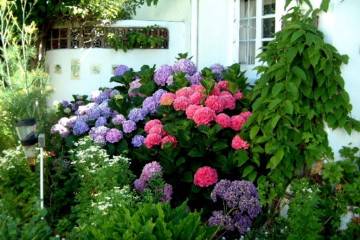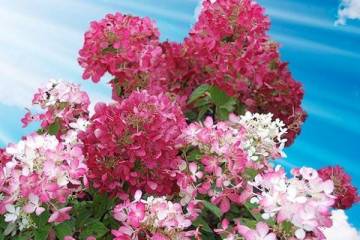Hydrangea on a stem - how to grow and shape
Content:
The variety of hydrangea varieties can satisfy the fantasies of any grower. This flower has beautiful and large serrated leaves, voluminous inflorescences. Lovers are also attracted by the possibility of using standard hydrangeas in landscape design. So they can be formed independently.
Hydrangea on a stem
Hydrangeas are a bush, but from the very beginning of cultivation, you can form a tree from it, that is, artificially lengthen the length of the trunk from the neck to the skeleton of the crown. But not all varieties of crops are suitable for this purpose. The stem plant is usually formed from a paniculate variety and a tree hydrangea.
Standard hydrangea paniculata: description
In general, standard plants are very popular for garden decoration. In the absence of a garden plot, a standard plant can be kept even on loggias and terraces in city apartments.
They are even formed from creeping cultures. But it is the panicle hydrangea (especially the Phantom hydrangea, Silver Dollar, Vanilla Strawberry, Grandiflora) with its chic paniculate inflorescences that attracts gardeners.
To form a tree, one of the strongest shoots is selected from the bush, and the rest are cut out. In the future, with each planned pruning, newly appeared shoots are removed. 5-6 skeletal branches are left at the top. It is from them that the crown is formed. It can be shaped in any shape, and regular pruning will add splendor (side stems will develop). The result is a tree densely covered with beautiful, green leaves and large inflorescences.
Stamp hydrangea in landscape design
Hydrangea is a genus of tall shrubs with strong branches. There are varieties that grow up to 3 m. This allows you to form a standard tree from a bush. In the landscape design of a garden plot, such a plant is used as a central figure, for example, in the middle of a mowed lawn, next to a gazebo, porch, terrace. Also, a number of such trees can be planted along roads, paths to decorate alleys.
Standard hydrangea looks great next to real trees. Especially laconic next to evergreen crops.
To hide the imperfections of garden buildings, the culture is planted in a row in a line and climbing plants, for example, maiden grapes, are allowed between the bushes.
How a hydrangea turns into a beautiful tree
Hydrangea belongs to centenarians. Once planted, you can admire the beautiful flowering for almost half a century. Naturally, only with good care. Without leaving, the hydrangea on the trunk may not disappear, but it will lose its decorative effect.
The formation of a standard tree from a bush lasts up to 8-9 years. Throughout this period, the seedling must be carefully cared for.The key role in the formation of a standard plant is assigned to timely and correct pruning of the trunk.
At the end of this period, the main work ends. It remains only to regularly arrange the crown and take care of the plant.
Choosing a landing site
All varieties are photophilous. But this does not mean that they can be grown in direct sunlight. The lace shade of large plants or buildings is more suitable for them.
Shading the tree is especially important in the southern areas. Under the sultry southern sky, culture will not only lose its attractiveness, but it may also perish. Especially a young plant.
For Central Russia, the northern side of the buildings, protected from the winds, will be suitable for a flower.
The soil for the culture needs acidic. Only then can you expect long-term flowering and bright colors. If the soil is sandy or alkaline, it is recommended to acidify it. Natural oxidants can be used:
- coniferous needles;
- high-moor peat.
Chemical additives can be added:
- ammonium sulfate;
- potassium sulfate.
How to form a panicle hydrangea on a trunk
When forming a standard tree with your own hands, it is very important to adhere to a certain sequence of actions. Then the question of how to form a panicle hydrangea on a trunk can be easily resolved.
It is very important to decide on the choice of the right crop variety for the stamping. The most correct decision is to buy a seedling in a specialized nursery. At the very least, you can be sure that the seedling matches the declared variety. Plus there is a choice.
Step by step, the process will look like this:
- Choosing the best way to create a standard plant. This is the main point.
- Careful selection of a seedling for a future tree. An adult plant will retain all the declared qualities of the shoot.
- Determination of the planting site of hydrangeas. Taking into account the duration of the process of stamping itself and the life cycle of the culture in general, the chosen place should be suitable for the general concept of garden design.
- Conducting mandatory regular pruning.
- The need for sufficient and regular watering.
- Timely fertilization and loosening of the soil under the tree.
All these actions will determine the creation of a hydrangea that looks as much like a tree as possible.
Ways to grow a standard plant
How to grow a hydrangea on a stem has been worrying amateur gardeners for a long time. There are two ways of growing a standard tree. You can get a tree from a bush:
- by grafting a crop cuttings onto the stump of any tree;
- the formation of a trunk from one process of the bush, removing the rest.
Both methods are successful. However, both of them have their pros and cons.
Vaccination as a way to obtain a standard form
By grafting, you can get a finished tree much faster, but the method is complicated. It is better to use them by more experienced specialists.
The process has two parts. The first is to choose a tree with an even, straight trunk, and the second is to get a strong cutting of a hydrangea with two or three eyes. The lower part (tree) is a bole. The upper part is a scion.
Grafting takes place like this:
- At the rootstock, the crown is cut off at the required height.
- On the upper cut, a split (vertical cut) up to 5 cm deep is performed with a knife.
- The lower part of the scion (hydrangea stalk) is cut with a wedge.
- The graft is inserted into the rootstock (tree trunk) split.
- The vaccination site is tightly wrapped with a film.
- The top of the cutting is cut to the upper bud.
- The cut is processed with garden pitch.
In this way, a flowering adult plant can be obtained at the end of 4 years.
Getting a trunk using shaping
Getting a standard hydrangea from a bush seedling is most convenient for inexperienced gardeners. The result is almost always successful.The only disadvantage of the method is the length of the process. It takes up to 8 years to get a full-fledged tree.
For growing a stem, a seedling with at least one very even and strong stem is selected. After planting a young bush, the selected stem is tied in several places to the support. All other shoots are cut off (so continue the entire period of formation).
Over time, the trunk will increase in length, so you must not forget to strengthen it additionally on the support. The formed crown should also be fixed on a peg.
When the seedling reaches a height of 1.5 m, crown formation begins. All skeletal branches are pinched, giving the top the desired shape. The next year, all lateral shoots that appeared after last year's pinching are cut off. And so everything repeats itself for the next and all subsequent years.
Thus, by the age of 7-8, a rather dense (branched) ball is formed at the top of the trunk.
When pruning, certain rules should be followed:
- pruning is carried out when the buds are already swollen;
- the young stem is cut to 4 buds;
- in the first season, the inflorescences are removed. This will ensure lush bloom the next season.
Preparing for winter
Almost all varieties of hydrangea are distinguished by excellent winter hardiness. Especially treelike and paniculate can winter well in severe frosts. But all this applies to adult plants. Young trees up to 5-6 years old need shelter for the winter, otherwise their buds may freeze.
How insulation can be used:
- dry leaves;
- peat;
- sawdust.
Top can be overlaid with spruce branches or covered with non-woven material.
When to apply top dressing
Like any ornamental plant, hydrangea responds to feeding with exuberant and long flowering. The sufficiency of trace elements depends on:
- color saturation and leaf size;
- crown density;
- the abundance and size of panicles;
- juiciness of shades of petals.
The first fertilizer is applied at the very beginning of summer (even at the end of spring). Top dressing can be poured / poured over the root zone or over the sheet.
Hydrangea should be fed with organic matter and urea throughout the growing season. It is enough to make them 1-2 times a month. It is recommended to combine top dressing with watering.
Urea is aimed at the development of new shoots, so from September it is necessary to stop feeding, otherwise the plant will not have time to prepare for winter (the juice will end late) and will not tolerate the cold well.
An excess of nitrogen will lead to an increase in green mass (foliage) to the detriment of flowering. The latter can be achieved by using potash phosphate fertilizers.
Paniculata hydrangea on a trunk is a really beautiful plant, but few imagine the possibility of independently growing such a miracle. Although planting and caring for a standard hydrangea are quite feasible tasks. If a number of conditions are fulfilled, a beginner can also do this, especially given the large number of available recommendations from experienced gardeners.
